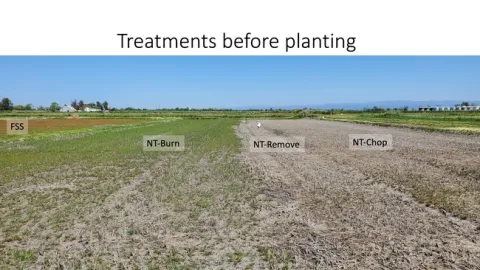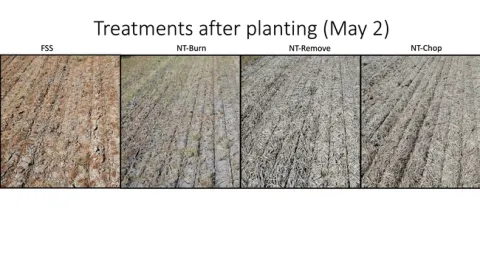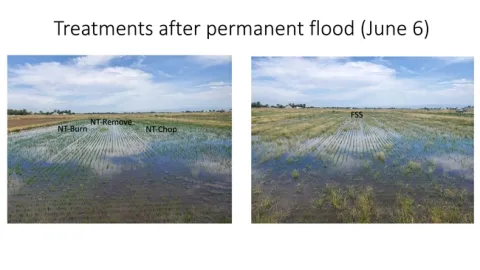Trying out no-till, drill-seeded rice
We are trying something this year that we have not ever tried. We are drill seeding rice into fields that have not been tilled this season. Why are we doing this? It is one way to save considerable amounts of irrigation water. We estimate that up to 0.5 ac ft/ac of water could be saved. Water savings are due to using existing soil moisture (from the winter/spring rains) and limiting the evaporation of water during the first month of the season by not having the field flooded. Other potential benefits include reduced tillage costs, the ability to plant early, and avoiding tadpole shrimp and midge injury.
We are looking at four different seedbeds to NT drill seed into.
- Fallow stale-seedbed (FSS): field was fallowed in 2022. It was disked and leveled then. It was not flooded during the winter. No tillage was done during 2023.
- No-till. We have three strict NT treatments. Rice was grown in 2022. After harvesting (harvested to limit ruts), the straw in the field was subjected to one of three treatments:
- Chopped (NT-Chop)
- Half removed to simulate baling (NT-Remove)
- Burned (NT-Burn)
The no-till fields were all winter flooded.

At the time of planting:
On May 2 the fields were all planted with a Great Plains no-till drill seeder (see above) at a rate of 150 lb seed/ac.
There were a lot of winter weeds in the NT-Burn and FSS treatments (with the wet spring we got more winter weeds than normal). While we tried to get rid of them by spraying glyphosate before drilling, many were tolerant. In the NT-Chop and NT-Remove treatments there were little to no weeds.
Soil moisture varied tremendously between the different treatments. There was a lot of moisture under the NT-Chop straw (too much for optimal planting). In the FSS and NT-Burn the soil was the driest with soil moisture at about 2 inches below the soil surface. We probably could have planted to moisture in the NT-Chop but due to the layout of the experiment, we gave all treatments an initial irrigation flush after planting on May 4 and the flush was drained on May 8.
We did not apply any herbicide at planting (either before or after the flush).

Just before a permanent flood:
We did not apply any irrigation water after the initial flush at planting until June 2 when we applied the permanent flood. The rice was at the 4-leaf stage by this time. We got a good stand in all treatments. The stand was lowest in the NT-Chop treatment but still good. The soil moisture in the NT-Burn and FSS was starting to dry out but we did not see any moisture stress. In the NT-Chop treatment, there was still a lot of moisture beneath the straw mat. The winter weeds were still present but we saw very few other weeds coming up. Just before permanent flood, we applied urea and herbicides (Prowl, Clincher and Propanil).
After the permanent flood, the plants almost doubled in height in the first few days and were well above the water line. As one can see in the pictures, the winter weeds persisted into the permanent flood. However, they did not appear to affect the stand of rice; but we will see as time progresses.

We are encouraged by what we are seeing early on. Obviously, we still have a long way to go. This year we are looking at potential water savings, weed problems and their management, and fertility management in these systems. If you are interested in this research and would like to visit the site, please let us know and we can try to arrange something. We will highlight this research at the Annual Rice Field Day at the end of August.
